Click on images to enlarge
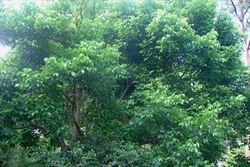
habit during spring (Photo: Sheldon Navie)
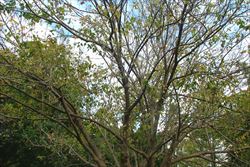
habit during autumn (Photo: Sheldon Navie)
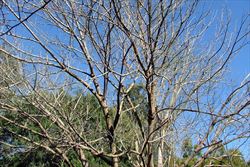
habit during winter (Photo: Sheldon Navie)
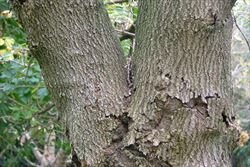
rough and shallowly-fissured bark on main trunk (Photo: Sheldon Navie)
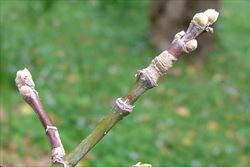
close-up of the stems and winter buds, with small scales covered in whitish hairs (Photo: Sheldon Navie)
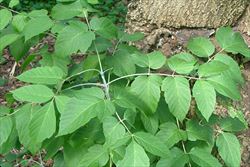
the large compound leaves are oppositely arranged and have 3-7 leaflets (Photo: Sheldon Navie)

leaf undersides are paler with prominent veins (Photo: Sheldon Navie)
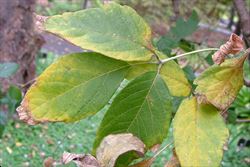
autumn leaf, showing the toothed margins of the leaflets (Photo: Sheldon Navie)
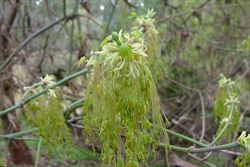
greenish-yellow male flowers borne in dense hanging clusters (Photo: Sheldon Navie)
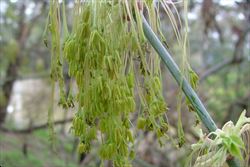
close-up of male flowers and whitish waxy coating on younger stem (Photo: Sheldon Navie)
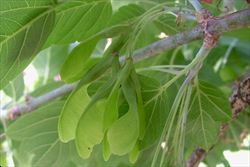
immature fruit, borne in dense clusters during spring (Photo: Sheldon Navie)
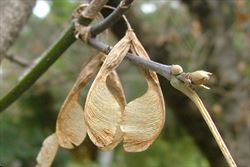
pale brown mature fruit (Photo: Sheldon Navie)
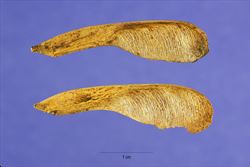
close-up of seeds (Photo: Steve Hurst at USDA PLANTS Database)
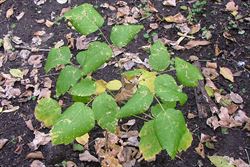
young plant during autumn (Photo: Sheldon Navie)
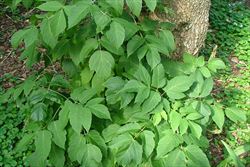
vigorous suckering from the base of a mature tree (Photo: Sheldon Navie)
Scientific Name
Acer negundo L.
Family
Aceraceae
Common Names
ash leaved maple, ashleaf maple, ash-leaf maple, ash-leaved maple, black maple, box elder, box elder maple, box-elder, boxelder, Manitoba maple, Negundo maple, three-leaf maple
Origin
Native to large parts of North America, from southern Canada through to Guatemala, including large parts of the USA and some parts of Mexico. Six distinct varieties and/or sub-species of box elder (Acer negundo) have been identified in the wild in North America.
Cultivation
A widely cultivated ornamental species, that is mostly grown in parks and gardens in the cooler and wetter parts of southern Australia. Numerous cultivars with attractively coloured or variegated leaves are generally grown these days, rather than the original species. However, some of these cultivars soon revert to wholly green-leaved plants when growing in the wild.
Variegated box elder (Acer negundo 'Variegatum') is the probably the most commonly cultivated form of this species nowdays. It has leaves that are marbled light green and creamy white. Acer negundo 'Violaceum' (also known as Acer negundo var. violaceum), Acer negundo 'Flamingo' and Acer negundo 'Kelly's Gold' are other popular cultivars.
Other less common cultivars include golden variegated maple (i.e. 'Aureo-marginatum' or 'Aureo-variegatum'), ghost maple (i.e. 'Argentium Variegatum' or 'Argenteo-variegatum'), yellow-leaved maple (i.e. ‘Auratum’), 'Sensation', 'Elegans' (also known as ‘Elegantissimum’), 'White Lightning' and 'Odessanum'.
Some of these modern cultivars (e.g. 'Variegatum', 'Flamingo' and 'Sensation') are reported to be fruitless (i.e. sterile), and have been suggested as more desirable replacements for the weedy forms of this species. These cultivars are also thought to be advantageous because they are slower growing, less likely to blow apart in strong winds, and have more attractive foliage.
Naturalised Distribution
Naturalised in some parts of south-eastern Australia including eastern New South Wales, the ACT, south-eastern South Australia and parts of Victoria.
The major infestations are currently in eastern New South Wales, especially in the cooler highland districts (i.e. northern tablelands, southern tablelands and in the Blue Mountains). In Victoria it is naturalised along the Plenty River in the outer Melbourne metropolitan area, and there are also scattered populations in southern and north-eastern Victoria. In South Australia it is mainly found near Adelaide, but their are also unconfirmed reports of it becoming naturalised in the Northern Lofty mountains region. It is sparingly naturalised in south-east Queensland.
Overseas, it has become naturalised in New Zealand, South Africa, Europe and South America. It has also become naturalised beyond its native range in North America, and is regarded as a weed in parts of Canada, Alaska and the USA.
Habitat
In Australia this species generally becomes naturalised in bushland along watercourses (i.e. in riparian vegetation) in temperate regions. It also grows in closed forests (e.g. wet sclerophyll forests).
It its native habitat, in North America, box elder (Acer negundo) generally grows on moist sites along lakes and waterways, on floodplains, and in low-lying areas.
Habit
A small to moderately large tree usually growing 6-15 m high and 8-12 m across, but occasionally reaching up to 20 m in height. It loses all of its leaves during autumn and winter, and is covered in new foliage each spring (i.e. it is deciduous).
Distinguishing Features
- a medium-sized tree with oppositely arranged compound leaves.
- its leaves have 3-7 leaflets with toothed or lobed margins.
- separate male and female flowers are borne on separate plants.
- male flowers borne in hanging clusters and consist mainly of prominent stamens, while female flowers are borne in drooping elongated clusters.
- its relatively large v-shaped fruit (3-4 cm long) consist of two prominently winged 'seeds' that are joined together at the base.
Seedling
Seedlings have two seed-leaves (i.e. cotyledons) that are relatively long and narrow (i.e. linear or lanceolate). The first pair of true leaves are usually simple with sharply-toothed (i.e. serrated) margins. As the seedlings grow, they develop leaves with three or more leaflets.
Stems and Leaves
Mature trunks have brownish-grey coloured bark that is rough and shallowly fissured. The younger branches are relatively smooth, hairless (i.e. glabrous) and somewhat shiny when they are young, but the developing bark becomes flaky in appearance on older branches. The youngest branches are rounded and green or purplish in colour. They are often initially covered in a whitish waxy or powdery coating that gives them a slightly bluish-green appearance (i.e. they are somewhat pruinose or glaucous). Dormant growing buds (2-5 mm long) are present at the tips of the stems during winter, and these usually have one or two pairs of scales that are covered in tiny whitish-coloured hairs.
The relatively large leaves (15-38 cm long) are oppositely arranged along the stems and are made up of 3-9 leaflets (i.e. they are pinnate). These leaves are borne on a stalk (i.e. petiole) 5-12 cm long and each leaflet has its own smaller stalk (i.e. petiolule). The leaflets are roughly oval or elongated in shape (i.e. ovate, elliptic or lanceolate) with margins that are irregularly or regularly toothed (i.e. crenate or serrate) and may, or may not, also be shallowly lobed. The side (i.e. lateral) leaflets are 4-12 cm long and 2-4.5 cm wide, while the end (i.e. terminal) leaflet is usually significantly larger in size (up to 15 cm long and 8 cm wide) with a longer stalk (i.e. petiolule). These leaflets are usually entirely bright green in colour, although sometimes they may have whitish-coloured blotches or margins (i.e. they may be variegated). Leaflets change colour as they age and eventually turn dull yellow or brownish before being shed during autumn and winter. The undersides of the leaflets are paler in colour, have prominent veins, and sometimes have a scattered covering of hairs that are more prominent along the veins.
Flowers and Fruit
The flowers appear just before, or with, the first leaves each spring, and are borne in the leaf forks (i.e. axils). Separate male and female (i.e. unisexual) flowers are usually borne on separate plants (i.e. this species is dioecious). Male and female flowers are both green or yellowish-green in colour and lack any petals. They also both have five tiny green sepals (about 1 mm long) and are arranged in drooping clusters (i.e. racemes) 2-15 cm long. The male flowers are borne on very slender drooping stalks (i.e. pedicels) 2-7 cm long and usually have five prominent stamens. The female flowers are borne on shorter and thicker stalks (up to 4 cm long). Flowering occurs during spring (i.e. from September to November).
The distinctive v-shaped fruit (3-4 cm long) are borne in drooping clusters and each fruit consists of two one-seeded structures that are prominently winged (i.e. a special type of mericarp called a samara). They are joined together near the base to form a 'double samara'. The seed compartment at the base of these structures is somewhat oval (i.e. ellipsoid) in shape and about 15 mm long, while the wings are prominently veined. Immature fruit are green in colour but turn yellowish and then pale brown as they mature. Mature fruit tend to remain on the female trees throughout summer and autumn, and even into the winter. The paired samaras usually eventually separate after they are shed. The seeds themselves are strongly wrinkled.
Reproduction and Dispersal
This species reproduces by seed. Large trees that are cut or damaged will re-shoot vigorously and can develop a dense mutli-stemmed habit. Similar shoots may also be produced from exposed or injured roots.
The winged fruit are designed to be spread by the wind, and they usually rotate in a propeller-like motion as they fall to the ground. These fruit are relatively light and are also spread by water, as well as in dumped garden waste. The seeds may also be dispersed by birds and other animals.
Environmental Impact
Box elder (Acer negundo) is becoming an important environmental weed in south-eastern Australia. It is currently regarded as an environmental weed in Victoria and New South Wales, and is also seen as a potential environmental weed in the ACT.
This fast-growing species is particularly invasive along waterways (i.e. in riparian areas) and in sheltered forests in temperate zones, but it has the potential to invade other habitats in south-eastern Australia. It crowds and shades out native plants in sensitive bushland along watercourses, and has become a major riparian weed of a some waterways. It is also thought that dense long-term infestations of this species may cause significant damage to waterways by trapping sediment, causing erosion and depleting oxygen levels in the water as a result of shedding large quantities of autumn leaves.
Box elder (Acer negundo) is probably most troublesome in the sub-coastal highland districts of New South Wales, but it is also present in coastal districts including in the Sydney region. Though there are only limited herbarium collections of this species, suggesting that it is not very widespread or commonly naturalised, it appears on many environmental weed lists in New South Wales (e.g. the Warringah Council environmental weeds register, the Australian Association of Bush Regenerators Bushland Weeds of the Sydney Region list, the Blue Mountains City Council bushland weed list, the NSW North Coast environmental weed survey list, the Ku-ring-gai Council Urban Environmental Weeds list, and the NSW South Coast Weeds list).
In Victoria it is believed that this species has the potential to become an environmental weed in many vegetation communities including dry coastal vegetation, heathy woodlands, grassy woodlands, dry and damp sclerophyll forests and woodlands. Box elder (Acer negundo) is reported to already be a problem at Wilsons Reserve in Ivanhoe and in Knox City Council within the Melbourne region. In fact some environmentalists believe it to be among the worst environmental weeds growing along waterways in Melbourne.
Box elder (Acer negundo) is also thought to have the potential to become a very serious environmental weed in the ACT. This concern has resulted in a Weed Management Plan being developed for this species. It was recently also declared a pest plant and its sale is now prohibited in the ACT.
Other Impacts
As well as being and environmental weed, this species can also cause other problems in urban areas. Older specimens tend to drop limbs during windstorms, and may cause significant damage to property. The winged seeds also readily germinate and may become a nuisance in gardens, in guttering, and in gaps in footpaths and driveways.
Legislation
This species is declared under legislation in the following states and territories:
- ACT: C4 - prohibited; a pest plant whose supply is prohibited in the ACT.
Management
For information on the management of this species see the following resources:
- the South Coast Weeds website at http://www.esc.nsw.gov.au/Weeds/index.asp.
Similar Species
Box elder (Acer negundo) may be confused with some other introduced species that are becoming weeds of bushland areas, including sycamore maple (Acer pseudoplatanus), Japanese maple (Acer palmatum), Norway maple (Acer platanoides) and narrow-leaved ash (Fraxinus angustifolia subsp. angustifolia). These species can be distinguished by the following differences:
- box elder (Acer negundo) has compound (i.e. pinnate) leaves with 3-9 relatively broad leaflets. The margins of the leaflets may be toothed (i.e. crenate or serrate) or slightly lobed. Its v-shaped fruit (30-40 mm long) consist of two one-seeded, and prominently winged, structures (i.e. samaras) that are joined together near the base.
- sycamore maple (Acer pseudoplatanus) has simple leaves with 3-5 deep and relatively broad lobes that resemble the fingers on a hand (i.e. they are palmately lobed). The leaf margins are also usually irregularly toothed (i.e. serrate). Its v-shaped fruit (30-55 mm long) consist of two one-seeded, and prominently winged, structures (i.e. samaras) that are joined together near the base.
- Japanese maple (Acer palmatum) has simple leaves with 5-7 very deep relatively narrow lobes that resemble the fingers on a hand (i.e. they are palmately lobed). The leaf margins are also usually irregularly toothed (i.e. serrate). Its v-shaped fruit (15-25 mm long) consist of two one-seeded, and prominently winged, structures (i.e. samaras) that are joined together near the base.
- Norway maple (Acer platanoides) has simple leaves with 5-7 deep and relatively broad lobes that resemble the fingers on a hand (i.e. they are palmately lobed). The leaf margins are also irregularly and deeply toothed (i.e. serrate). Its relatively large fruit (35-50 mm long) consist of two one-seeded, and prominently winged, structures (i.e. samaras) that are joined together near the base. Its leaves and younger stems exude a milky-white sap (i.e. latex) when damaged.
- narrow-leaved ash (Fraxinus angustifolia subsp. angustifolia) has compound (i.e. pinnate) leaves with 5-13 relatively narrow leaflets. The margins of the leaflets are usually toothed (i.e. serrate). Its fruit (30-40 mm long) is a single one-seeded, and prominently winged, structure (i.e. samara).
In addition there are a few closely related natives called whitewoods (Atalaya spp.) and booyongs (Argyrodendron spp.) that have very similar winged fruit (i.e. double samaras). However, these species can be easily distinguished by their leaves, which usually have narrower leaflets with entire margins. Also, their small flowers have petals and they generally retain their leaves all-year-round (i.e. they are not deciduous).

